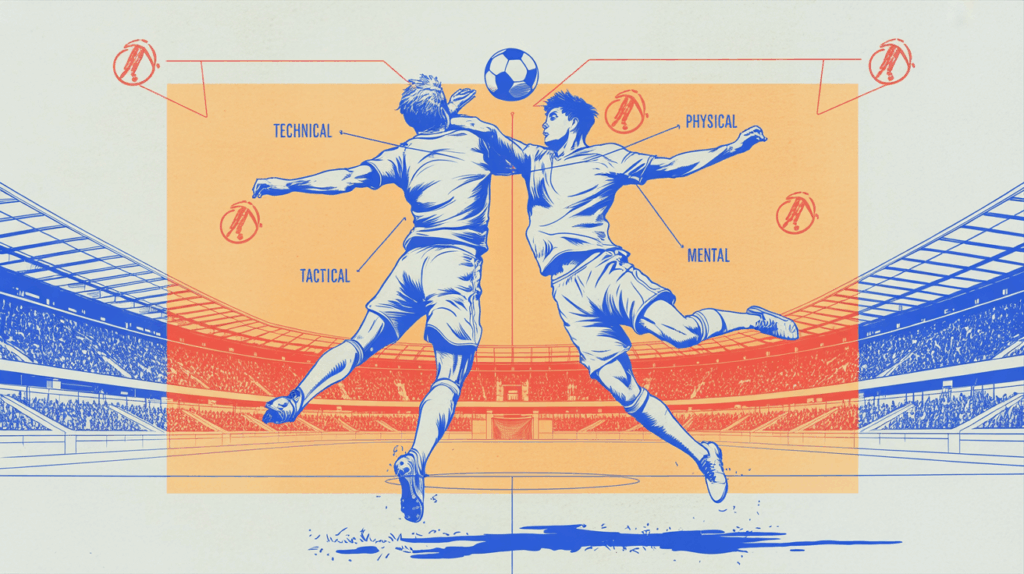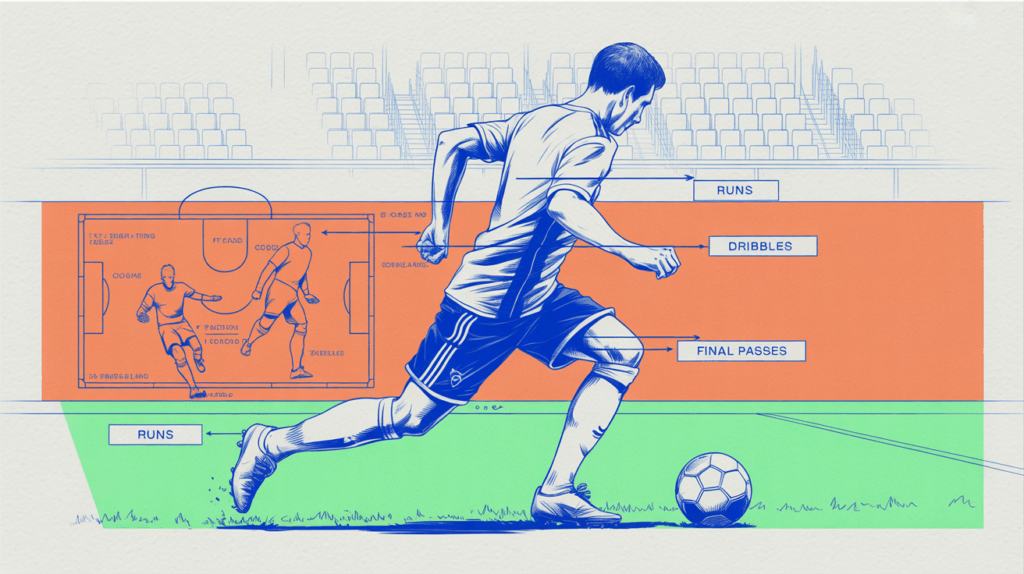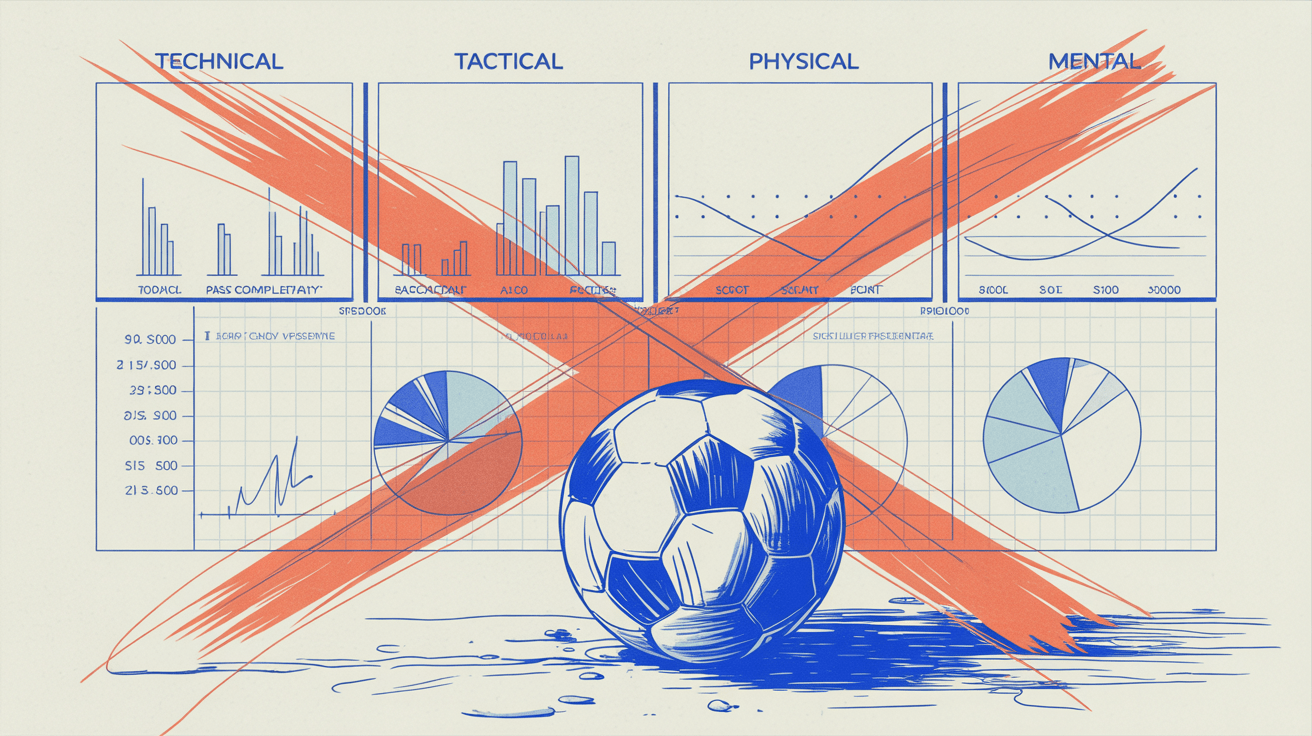Do you still use the ‘technical–tactical–physical–mental’ structure to evaluate players? Stop doing that, it’s very outdated and not effective at all. Here is why.
Competencies
Shooting
Imagine you describe a striker’s shooting ability. To which category (technical, tactical, physical, mental) does that belong?
The answer is: to all.
Let’s write down one example per category.
- Technically. How precise are his shots?
- Tactically. Does he make good decisions about which corner to aim for?
- Physically. Does he have the power to shoot with a lot of speed?
- Mentally. Do multiple missed chances in a row negatively affect his next shot?
Aerial duels

Next, you want to evaluate the ability of that same striker to win aerial duels when the goalkeeper kicks the ball long.
Again, let’s provide one example per category.
- Technically. Does he jump with the right foot?
- Tactically. Does he estimate the trajectory of the ball correctly?
- Physically. What are his height and his jumping power?
- Mentally. Can he maintain his concentration level?
Link up play
Last but not least, you evaluate the striker’s ability to link up play from short passes.
- Technically. Accuracy in his passes.
- Tactically. Knowing when to move into free space.
- Physically. Strength to hold off the defender.
- Mentally. Keep receiving, even after a failed pass.
Report
So, after evaluating this striker extensively in three areas, how on earth are you going to write a comprehensive report within the technical-tactical-physical-mental framework?
In the ‘technical’ paragraph, you’d write only about the technical components of shooting, aerial duels and link up play. And then in the ‘tactical’ paragraph, you’d write about their tactical components. Et cetera.
That doesn’t make sense, right? As if there is one common denominator in each component. Spoiler: there isn’t!
Technically, a striker can be extremely capable when it comes to shooting and yet extremely poor at aerial duels. Similarly, when it comes to his game intelligence (tactically), a midfielder can be extremely poor offensively, but extremely good defensively.
So why put them together in one category?
There is a better way to evaluate football players
Alternative
How could you evaluate players alternatively then?
By looking at the core competencies for each position, divided into attacking and defending.
Let’s give two examples: goalkeepers and wingers.
Goalkeepers
Defending
- Shot stopping
- Long-range shots
- Close-range shots
- 1v1 situations
- Defending depth
- Defending crosses
Attacking
- Ball retention
- Ball progression
In other words: you start describing the defensive abilities of a goalkeeper, in several categories. Next, you start describing the goalkeeper offensively, in two more categories.
Overall, you describe the goalkeeper in a logical sequence, enabling the reader to visualize the situations you are writing about.
This is just one example, you can pick your own topics. The point is that you can now be very specific and clear in your description.
Wingers

Attacking
- Runs in behind
- Dribbels
- Final passes
- Playmaking
Defending
- High pressing
- Tracking back
The same applies to wingers. You start by covering four offensive topics that are very important for wingers. (Or three, or five, that’s up to you.) Then you describe two defensive topics. Obviously, you can start with an introduction, and finalize with a summary.
Clarity for the reader
Now, let’s compare two reports. The first one is compiled based on the technical-tactical-physical-mental framework. The second one is based on the core competencies per position. Decide for yourself which one gives you a better understanding of the strengths and weaknesses of the player.
Example report 1 – Winger
Technically, he is fairly good. Crosses and through balls are at a decent level, and when he receives the ball between the lines, his first touches and passes are often solid. His pressing actions on the opponent’s half are generally executed well, on a high intensity.
Tactically, he is inconsistent. He understands well when to make runs behind the opponent’s defense, although he should improve his starting position and timing. He regularly misses opportunities for a through pass or cross. In between the lines, in crowded areas, he often makes poor decisions.
Physically, he mainly relies on his short-distance speed and agility. He is small and lacks upper-body strength. He is easily knocked off balance and lacks height.
Mentally, he looks eager, presses with full conviction, and transitions at full speed. He struggles to maintain concentration throughout the match and seems affected by high-pressure matches.
Example report 2 – Winger
When a teammate has time on the ball and there is space behind the defense, he frequently makes high speed runs in behind. However, he can improve the starting position and timing of his runs.
When he receives the ball wide, he is explosive in his dribbles and can beat his man both inside and outside thanks to his acceleration and quick change of direction. He struggles when the opponent can get into a duel while he’s dribbling because of a lack of upper body strength.
In situations where he can deliver a final pass, he too often lacks awareness. He then focuses too much on the ball, and ends up missing opportunities for through balls or crosses. When he does play them, their quality level is often quite good.
He struggles to receive between the lines or to combine under pressure in tight spaces. He finds it difficult to shield the ball and is too often unaware of his surroundings. But when he knows the right solution, his first touches and passes are usually of solid quality.
During his team’s high press, he consistently closes the center of the pitch to force the ball wide. He then presses with great intensity, although he sometimes gets dribbles past too easily because he doesn’t decelerate in time.
When his team defends in their own half, he doesn’t close the gap to his team’s fullback enough. He is also frequently late when defending against an overlapping fullback.
See how much clearer and more specific the second one is? It’s way easier for the reader to get a good understanding about the player: what type of player he is, what his strengths are, what his weaknesses are, et cetera.
So, from now on, discard the technical-tactical-physical-mental framework and describe players per position instead!
If you want to learn in great detail how to write the best possible scouting reports? Check out our scouting courses!



